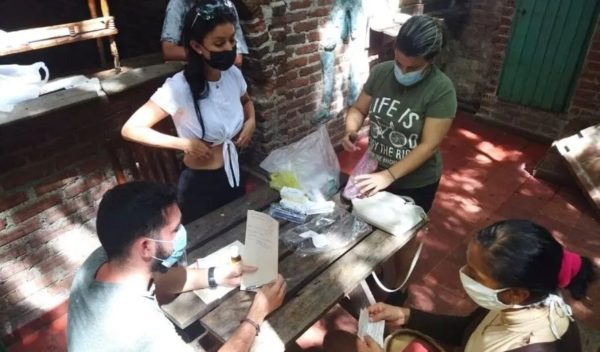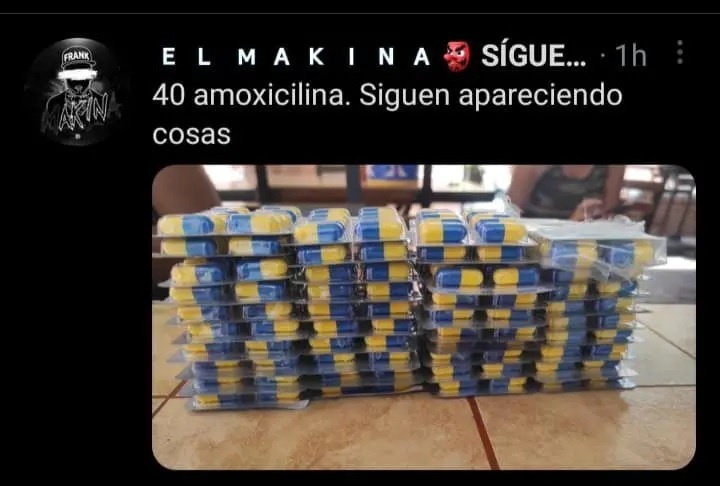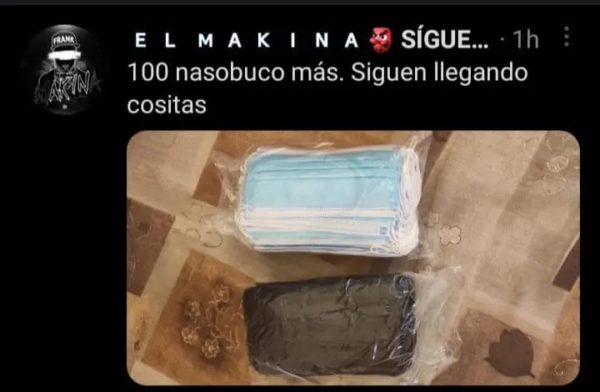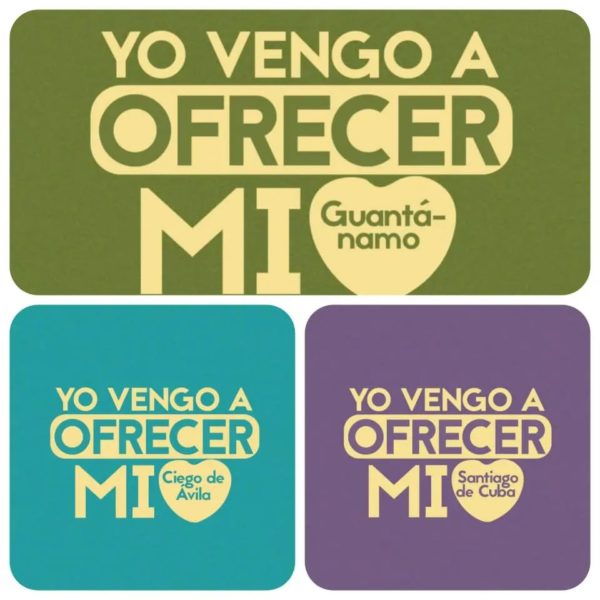Cubans Manage Aid Via Solidarity Networks Nationwide

HAVANA TIMES – Almost a year after Cuba effectively handled the COVID-19 pandemic and regarding the country’s historic results in terms of health, the public health system has collapsed over the past few months. Medical staff are just about managing to attend to the over 4,000 people admitted into health facilities right now. Medicine shortages, hospitals and other spaces equipped to take in patients are pushed to the brink, and the collapse of necrological services… these all form the landscape of Cuba’s current crisis.
Under these circumstances, some people are trying to take advantage of the situation; while others, a lot of people, have decided to put all of their strength and hearts into helping however they can.
Projects to support those most in need have popped up across the island. They are made up of people, especially young people, who collect donations of medicines, food, personal hygiene items, money and all kinds of supplies, to then distribute them to the people that need them the most in every province. Some projects are working nationwide, like “Solo el amor”, which has taken aid to almost every province in the country, and others are just focused on local communities. elTOQUE reached out to some of their activists.
#SOSMatanzas by Thais Liset and Frank “el Makina”

Mid-June marked a before and after in COVID-19 infections and deaths in Matanzas and the rest of the country. Matanzas residents were desperate amidst shortages of medical supplies and this opened the eyes of authorities who were reluctant to admit the gravity of the situation. #SOSMatanzas became a trending hashtag on Twitter, as did #SOSCuba.
Donations began to flood in for this province. One of the projects was being led by Havana YouTuber Frank “el Makina” and Thais Liset Hernandez, CEO of Pixel Cubano. These young people launched an appeal from the capital, and in a few days, they had collected resources to help Matanzas locals with what they collected.
“The idea came to us from Twitter. First, we thought about going to the isolation centers there; but we knew that getting authorization to do this would be a long process. So, we looked for a more viable way to help out: via donations,” Thais says.
Alongside Thais and Frank, the main team is made up of another three people who live in two households, where they receive the donations, separate them and then send them where they are needed.
National debit cards in CUP and MLC were made available for money deposits, as well as cryptoactives on the QvaPay platform. Information about these bank movements, as well as purchases made, were all published on Thais Liset’s Twitter account (@thais-liset).
It began in Matanzas but it soon spread to other hard-hit provinces: Ciego de Avila, Pinar del Rio and, most recently, Cienfuegos. Aid goes to very critical cases in Havana.
In every province, there’s a group of volunteers responsible for carrying out a census of COVID-19 positive patients around them. This has been the way they have worked in Matanzas and Cienfuegos, where aid is delivered personally to their door.
“In Ciego de Avila, young volunteers have been authorized to go into hospitals, so they prepare bags with medicine, food, masks, personal hygiene items, and they distribute them there. They have managed to go into hospitals with children who have tested positive now too,” Thais says.

Doctor Donations Group
The commotion on July 11th took Luis Daniel Gonzalez by surprise, as he cycled through Cienfuegos. It was only when he got to his house, after 3 PM, that he learned that protests had broken out all over Cuba. He had been collecting and delivering donations to help COVID-19 patients in his city.
It was the first week that the Doctor Donations Group had gone live; which had limited donations during those days, because of Internet cuts. The pandemic situation in the city led to a group of 15 young people (7 of whom were doctors) to try and alleviate the situation of COVID-19 patients.
They activated a card in pesos (CUP) and another one in MLC (USD) to receive donations. They raised around 40,000 pesos, which has been used to buy medical supplies such as gloves and masks, medicines and food. Part of this sum, some 9,000 pesos and 96 dollars, was sent to Matanzas as aid. (The official exchange rate is 24 pesos to one USD although the street exchange is over 60 x 1.)
Throughout July, volunteers went to isolation centers, especially pediatric ones, and to some neighborhoods in the city. “We got in touch with GP clinics to ask who needed help. We made two kits: one with personal hygiene items and another one with food, depending on what we were able to buy,” explains Antuan Andres Silva, a 23-year-old electrical engineer and one of the group’s organizers.
These activities are currently suspended for the time being, as some group members have caught COVID-19 or have had to go into self-isolation because they’ve been in contact with positive cases. “I still have money on me to buy some more medicine,” Silva says in the middle of a break.
Picking up medicines for people who need them the most is the Doctor Donations Group’s main mission and they have done this all of the time. They update the list of medicines available via three WhatsApp groups. People interested can write directly to the group’s administrators to ask for them.
“They need to explain the patient’s symptoms to us. We discuss it between the group’s directors to decide which treatment is needed and the dose,” Antuan clarifies.
Shortages in Cienfuegos has been the main obstacle, which has prevented them from buying more medical supplies. In addition to donations, they have had to turn to the illicit market in order to get medicines, as well as to people who bring them over from other countries, and prices are normally extremely high.
I’ve come to offer my heart
On July 25, 2021, Pinar del Rio journalist Yuliet Perez Calaña launched an appeal on Facebook asking for people to send aid to Ciego de Avila, Santiago de Cuba and Guantanamo, in their fight against COVID-19. Everyone’s eyes (and donations) were still on Matanzas, while the situation had become a lot worse in the rest of the country too. A few hours later, Perez Calaña had created a Facebook chat group with dozens of people.
It was chaos in the beginning; there wasn’t an exact plan. Aid slowly became more and more organized, depending on the needs of every province. Today, the project is most active and dynamic in WhatsApp groups. This is where specific cases are discovered and group admins can assess how best to manage donations. They try and solve at least one person’s needs. every day.
In Ciego del Avila, their work has been more focused on helping vulnerable children, both because of COVID-19 as well as those living in poor living conditions. “We have taken games, school packs, yoghurts, compotes, milk… to them,” Yuliet says.
The first delivery they made was to an isolation center for children and pregnant women in Moron, the city where the project also ran an initiative to collect and deliver children’s books.
Cynthia Valdes, the project coordinator in this municipality, says: “I get support from my classmates who do the rounds to find out who is in the most vulnerable situation. That’s how we work.”
Meanwhile, Leidy Lopez, who manages aid in the provincial capital, says that bank accounts have been set up to receive donations. Other donations are collected at her home, and a WhatsApp group is used to determine how to manage the resources according to need, both with medicine donations as well as personal hygiene and food items.

In Guantanamo, the project concentrates on helping people who have tested positive and have been told to stay at home. In addition to making sure that basic essentials make it to people most in need, “a WhatsApp group was created for doctors in the province who were willing to visit patients after their work day. Plus, they answer patients’ questions and queries, as many people haven’t been seen by a professional and are self-medicating,” Yuliet says.
The project is run by eight people in the far-eastern province, and there are also volunteers. “Everyone has their job to do. There are two girls in Havana who are responsible for picking up donations there and sending them; we also have a friend at the Bus Station who helps us send these donations so they can get to their destination as soon as possible,” Vivi Gonzalez Balben, said the provincial coordinator.
They have institutional support in Santiago de Cuba. Supplies are collected at the Hermanos Saiz Association, via a courier system that has been created by the institution, and it is used for both donations and distribution. The first large donation was sent to a center of pregnant women suspected of being infected with SARS-CoV-2 or having tested positive. They haven’t stopped ever since then.
Santa Clara por la vida
Another project was born in the country’s interior, and it’s growing every day: Santa Clara por la vida. In light of the situation in Matanzas and increasing numbers of cases in Villa Clara, writer Debora Garcia decided to help her fellow locals. She contacted actress Lizandra Martin and together they chose everyone’s home in Villa Clara to become an operations center: El Mejunje de Silverio. Raul E. Gutierrez (el Yuka), filmmaker, created a promotional video for social media.
Lizandra says the following about the project: “We were four or five people when we started out. A few days afterwards, we had 25 volunteers in the WhatsApp group, and almost double that number in people have joined in. They help us with transport, hand out donations, receive donations, we take food to residential homes for the elderly and we give out medicines.
“Yinet, the admin of Facebook group “Donde hay en Santa Clara”, coordinates the entire journey outside the province. Pedro, a small business owner, created the oxygen adaptors that are being used in the hospital and they’ve gone as far as Remedios and Cienfuegos. Silverio and two friends from the LGBT+ community make food at home to then deliver it on the weekend. Another group goes out in a truck and on motorbikes to distribute aid parcels. The latter are bought with money that people donate to the group and they are transparent with all of the expenses and what the money is being spent on.
“We’re learning along the way and looking for ways for us to each to do our job better. It’s a young project and we are still making mistakes and learning from them, but we are trying to be as transparent as possible.”
Up until now, they have received help from approximately 300 people and have reached over 40 homes with all kinds of supplies and medicines.





